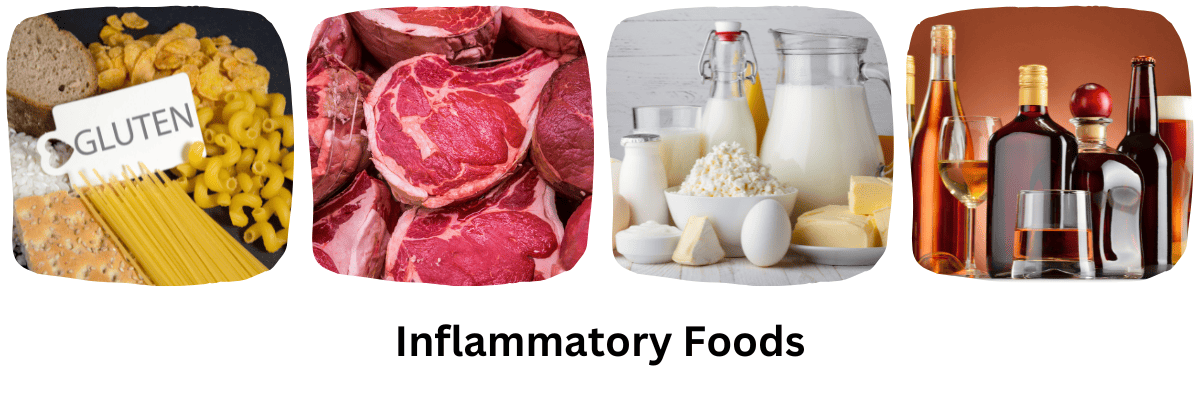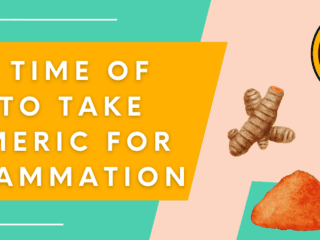Joint inflammation puts quite a toll on physical movement and makes the day harder to bear. But it’s not only injuries and overuse that lead to it, sometimes it’s the food (or beverages) you may be too fond of eating.
Today, we’re listing down some of the foods that cause inflammation in joints. We’re also listing down some anti-inflammatory food alternatives; how to make the most out of them and tips to manage inflammation symptoms.
- Foods That Cause Inflammation in Joints
- Understanding Joint Inflammation
- The Science Behind Food and Inflammation
- Foods That Can Cause Joint Inflammation
- Foods That Can Help Reduce Joint Inflammation
- Practical Tips For An Anti-Inflammatory Diet
- The Role Of Gut Health In Inflammation
- Lifestyle Factors That Influence Joint Inflammation
- What Does Joint Inflammation Look Like on an MRI?
- The Role of Medical Treatment in Managing Joint Inflammation
- Frequently Asked Questions (FAQs)
- What is the connection between diet and joint inflammation?
- Can changing my diet reduce joint inflammation?
- Are there any other lifestyle changes that can help reduce joint inflammation?
- Are there any specific diets recommended for people with joint inflammation?
- How quickly can dietary changes affect joint inflammation?
- Recap
- Conclusion
Foods That Cause Inflammation in Joints
1. Processed Sugars: Found in candies, sodas, and many processed foods.
2. Trans Fats: Present in fast foods, fried products, and certain margarines.
3. Red Meat: Especially those that are not grass-fed or organic.
4. Gluten and Casein: Found in wheat and dairy products, respectively.
5. Refined Carbohydrates: Such as white bread, white rice, and pastries.
6. MSG: A food additive used to enhance flavor in many packaged foods.
7. Alcohol: Excessive consumption can lead to inflammation.
It’s essential to monitor your diet and note any flare-ups after consuming specific foods. Consulting with a nutritionist or healthcare professional can provide personalized advice.
Understanding Joint Inflammation

Inflammation in general, is a normal part of the body’s healing process. It occurs when the immune system sends inflammatory cells and cytokines to protect the body from bacteria, infections, injuries, allergens, or organisms that cause infections, and this response results in symptoms like pain, swelling, and tenderness.
There are two types of inflammation:
- Acute inflammation – Acute inflammation is the body’s response to sudden body damage. It can result from either exposure to a substance (e.g., insect bites/stings or dust), injuries, or infections. Its symptoms include pain, swelling, redness, and high body temperature.
- Chronic inflammation – Chronic inflammation occurs when the immune system releases inflammatory cells, even without injuries and infections, which increases the risk of chronic autoimmune diseases, such as Alzheimer’s and type 2 diabetes. Symptoms include abdominal pain, fatigue, stomach problems, and rashes among others.
Causes Of Joint Inflammation
Joint inflammation can be linked to the following factors:
- Injuries – An injury to a joint usually causes localized inflammation. Injuries like ACL tears, meniscus tears, patellar tendonitis, bone fractures, sprains, and dislocations also tend to cause occasional joint inflammation and pain.
- Osteoarthritis – Osteoarthritis is an inflammatory disease that wastes away the cartilage of the joints, making mobility difficult and painful.
- Rheumatoid arthritis – An autoimmune disease involving the swelling of the synovial membrane that covers the knee joints resulting in stiffness and pain, which can go from mild to severe.
The Science Behind Food and Inflammation
Certain foods may cause or increase the risk of inflammation. Foods that are high in food colorings, additives, unhealthy fats, sugars, carbohydrates, preservatives, and other unhealthy substances put the body at risk of inflammation, especially when they’re consumed in excess.
How do these foods cause inflammation? Endocrinologists explain that fats, sugars, grains, and other carbohydrates can directly activate pro-inflammatory substances and indirectly result in unhealthy weight gain, which can then put the body further into an inflammatory state. They can also upset the gut microbiome balance, which is strongly linked to the inflammatory process, and cause symptoms.
Foods That Can Cause Joint Inflammation

Here are some foods that are known to cause joint inflammation:
Processed Foods
All types of processed foods can result in inflammation since they can alter the gut microbiome and can affect the gut’s link with the immune system and eventually trigger it in a way that leads to chronic inflammation.
Examples of this include:
- Breakfast cereals
- Processed meats (e.g., bacon, sausages, ham, etc.)
- All canned foods
- Frozen foods
- Bread
- Junk foods
- Sweets
Sugary Foods & Drinks
Anything sweet and sugary can induce the risk of inflammation. Processed sugars such as maltose, fructose, dextrose, glucose, and sucrose can trigger and release cytokines, which activate the body’s inflammatory processes
Red Meat
Studies show that excessively eating red meat (beef and pork), as well as processed meats, is linked to inflammation, oxidative stress, and compromised immune function. Red meat is rich in serum iron and an excessive amount of it in the body can result in oxidative stress and trigger an inflammatory reaction.
As a result, more experts recommend a more moderate consumption of red meat in general.
Gluten
Gluten triggers inflammation in people with autoimmune diseases like celiac disease, Crohn’s, and rheumatoid arthritis, as well as those with non-celiac gluten sensitivity. Foods that contain gluten include bread, pasta, crackers, baked goods, certain grains, alcoholic drinks, and other processed food and beverages.
Dairy
Whole milk and full-fat dairy products can cause inflammation because they have saturated fats, which are the main fat found in all dairy products. While dairy products don’t usually cause inflammation symptoms among most people, they do so among those who have lactose intolerance.
Alcohol
Many studies point out that alcohol drinking can cause inflammation in the intestines and greatly affects gut health, where it can disrupt the gut microbiome balance by increasing inflammation-causing bacteria and causing the wall of the gut lining to become more permeable.
Excessive alcohol drinking can damage the immune cells and make one more prone to bacterial and viral infections in the lungs and respiratory tract.
Foods That Can Help Reduce Joint Inflammation
Anti-inflammatory foods and substances are rich in essential nutrients and provide a good balance of carbohydrates, fats, and proteins to help reduce inflammation altogether. Studies show that such an anti-inflammatory diet can help yield a healthy aging process and relieve the body’s inflammatory processes.
Various studies show that anti-inflammatory diets may help reduce inflammation symptoms such as fatigue and swelling. Another study showed that an anti-inflammatory diet can also help promote weight loss, especially among pre-diabetic and diabetic patients.
As we can observe, an anti-inflammatory diet encourages replacing heavily processed, artificially-flavored ones with more fresh food sources, such as:
Vegetables
Studies show that leafy greens like kale, spinach, collards, broccoli, endive, turnip greens, and beet greens all contain significant concentrations of vitamins, particularly vitamins A, C, E, and K, and other nutrients that have been found to reduce chronic inflammation.
They also aid in managing healthy cholesterol levels, preventing cancer and heart disease, and boosting joint and bone health.
Fruits
Fruits like apples, blueberries, blackberries, strawberries, pomegranates, and cherries are particularly rich in anti-inflammatory properties and antioxidants like ascorbic acid, anthocyanins, and carotenoids which offer protection against free radicals that cause inflammation and decrease the risk for heart disease and certain cancers.
Whole Grains
Whole grains like oatmeal, brown rice, whole-wheat bread, and other unrefined grains are high in fiber, which may also help with inflammation. Other healthy whole grains include buckwheat, brown or wild rice, quinoa, amaranth, flax, and basmati.
Legumes
Several studies show that legumes, such as beans, peas, and lentils are rich in bioactive compounds such as peptides, polyphenols, and saponins which have potent antioxidant and anti-inflammatory properties.
Healthy Fats
Omega-3 fatty acids are considered essential fats, which means the body can’t make them on its own but must get them from food sources. Examples of omega-3-rich foods include:
- Fatty fish (e.g., salmon, mackerel, sardines, and anchovies)
- Nuts (e.g., walnuts, macadamia, pecans, almonds, and hazelnut)
- Seeds (e.g., pumpkin, chia, and flaxseed
Studies have found that a healthy balanced diet composed mainly of omega-3-rich foods can greatly improve heart health and reduce the risk of coronary heart disease-related death and stroke and that they contain anti-inflammatory properties.
Poultry
Chicken and eggs are both rich in arachidonic acid â an omega-6 fatty acid involved in the body’s inflammatory response, brain development, and neuron protection. Eggs in particular are likewise a rich source of vitamin D, which has anti-inflammatory effects.
Herbs & Spices
Various herbs and spices such as cinnamon, ginger, ginseng, black pepper, and rosemary contain powerful anti-inflammatory properties. Turmeric, in particular, is anti-inflammatory properties thanks to curcumin, the substance that also gives it its rich yellow hue and flavor. Ashwagandha, an Ayurvedic herb, is also rich in anti-inflammatory properties that protect the brain, reduce stress, and prevent the risk of many diseases.
Practical Tips For An Anti-Inflammatory Diet
Incorporating anti-inflammatory foods into your daily diet is the next step. To help you get started, you can look at this sample meal plan arranged for every day of the week:
Sunday
- Breakfast: Buckwheat pancakes with berries
- Lunch: Grilled salmon served with green beans
- Dinner: Sautéed sardines (in garlic and onion)
Monday
- Breakfast: Oatmeal topped with fresh fruit of your choice
- Lunch: Chicken pumpkin and quinoa soup
- Dinner: Crispy salmon aglio olio pasta (with whole-grain pasta and olive oil)
Tuesday
- Breakfast: Tuna omelet with whole-wheat bread
- Lunch: Air-fried chicken served with brown rice topped with vegetables
- Dinner: Honey garlic chicken breast slices
Wednesday
- Breakfast: Fresh-sliced fruits
- Lunch: Grilled sauerkraut, hummus, and avocado sandwich
- Dinner: Baked eggs over sautéed mushrooms and spinach
Thursday
- Breakfast: Mackerel and quinoa bowl topped with a sunny-side-up egg
- Lunch: Quinoa and citrus salad
- Dinner: Mixed greens and chicken salad
Friday
- Breakfast: Salmon, avocado, and poached eggs on whole-wheat bread toast
- Lunch: Vegan lentil soup with kale, chickpeas, and carrots
- Dinner: Turbo-cooked tilapia glazed with pineapple sauce and black Tausi beans
Saturday
- Breakfast: Blueberry overnight oats with honey
- Lunch: Fish (tuna) sinigang soup with brown rice
- Dinner: Mediterranean chicken with Brussels sprouts & gnocchi
The Role Of Gut Health In Inflammation
Gut health and the inflammation process are inexplicably linked to each other, so the state of the gut microbiome can affect inflammation.
An unideal gut microbiota composition can influence the presence of pro-inflammatory immune cells that produce cytokines, which in turn can trigger the inflammation process. The imbalance in the gut microbiome can also decrease the absorption of nutrients and negatively affect overall digestive health.
Probiotics aim to restore the healthy composition of the gut microbiome and introduce important functions to gut microbial communities to prevent gut inflammation and other intestinal diseases. Probiotic-rich foods include:
- Sauerkraut
- Kimchi
- Kombucha
- Tempeh
- Water kefir
- Miso
- Sourdough bread
- Fermented dairy alternatives (Soy- and nut-based milk and yogurts)
Lifestyle Factors That Influence Joint Inflammation
- Eating healthier – Eating a healthier diet composed mostly of vegetables, legumes, fatty fish, poultry, and fruits can help reduce the effects of bodily inflammation and mitigate existing symptoms.
- Get physical exercise – Physical therapists usually recommend exercise plans for osteoarthritis to strengthen the muscles and restore joint function.
- Quit smoking – If you’re a smoker, now is the best time to cut the habit. Smoking increases oxidant stress, which destroys cartilage, inhibits cell proliferation, and increases carbon monoxide in the blood, which also prevents cartilage from repairing itself.
- Get plenty of rest – Getting enough rest both daytime and nighttime helps the body recover from overuse and joint pain flare-ups.
Supplements For Joint Inflammation
Dietary supplements can help with joint inflammation by mitigating the effects on pain and function in patients who suffer from constant joint pain. Supplements that contain anti-inflammatory ingredients like omega-3s, turmeric, cinnamon, chondroitin, and glucosamine have been lauded for their effects in managing joint pain inflammation.
What Does Joint Inflammation Look Like on an MRI?
Joint inflammation can manifest in various ways on MRI (Magnetic Resonance Imaging). MRI is a valuable tool for diagnosing and assessing the severity of joint inflammation because it can visualize both bone and soft tissue structures in detail. Here’s what joint inflammation might look like on an MRI:
- Bone Marrow Edema: This appears as areas of increased signal intensity on T2-weighted images and STIR (Short Tau Inversion Recovery) sequences. It indicates inflammation within the bone.
- Joint Effusion: An increased amount of fluid within the joint space can be seen. This fluid appears bright on T2-weighted images.
- Synovitis: The synovium is the lining of the joint. When inflamed, it can thicken and may produce excess fluid. On MRI, an inflamed synovium appears as thickened tissue with increased signal on T2-weighted images.
- Erosions: These are areas where the bone has been worn away due to chronic inflammation. They appear as breaks or gaps in the normally smooth outline of the bone.
- Soft Tissue Swelling: Surrounding tissues, including tendons and ligaments, may appear swollen and have increased signal intensity on T2-weighted images.
- Cartilage Loss: MRI can show thinning or absence of the cartilage that normally covers the ends of bones in a joint. Loss of cartilage is a hallmark of osteoarthritis.
- Tendon and Ligament Abnormalities: Inflammation can also affect tendons and ligaments around the joint. MRI can show thickening, tears, or other abnormalities in these structures.
- Enhancement with Contrast: If a contrast agent (like gadolinium) is used, areas of active inflammation may “enhance” or appear brighter on the post-contrast images. This is especially useful for visualizing synovitis.
- Ankylosis: In severe cases, especially in conditions like ankylosing spondylitis, the bones of the joint may fuse together. This appears as a loss of the joint space and continuity of the bone across the joint.
It’s important to note that while MRI provides detailed images of joint structures, the interpretation of these images should be done by a radiologist in conjunction with clinical findings. If you suspect joint inflammation or any other joint pathology, it’s essential to consult with a healthcare professional for a comprehensive evaluation.
The Role of Medical Treatment in Managing Joint Inflammation
An anti-inflammatory diet is an effective way to prevent and relieve inflammation symptoms early on, but it may not be enough for more serious cases of inflammation, which require medical treatment:
There are various medical treatments available for joint inflammation:
- Over-the-counter medications – OTC pain relievers and prescription anti-inflammatory drugs like ibuprofen (Advil), acetaminophen (Tylenol), and duloxetine (Cymbalta) are often recommended for people people who suffer mild to moderate joint inflammation flare-ups.
- Injections – Injections provide relief for joint pain from inflammation. Corticosteroid injections, for example, target and relieve the inflammation itself, while hyaluronic acid injections lubricate the joints to help increase mobility and comfort.
- Physical therapy – Physical therapy is a popular treatment for osteoarthritis, which significantly aids in relieving severe symptoms and helps improve strength and flexibility in the joints, which can reduce pain and prevent future injuries.
In the more extreme cases of arthritis, surgical procedures like joint replacement surgery might be required. This procedure involves replacing parts of an arthritic or damaged joint ad with a metal, plastic, or ceramic prosthesis.
Frequently Asked Questions (FAQs)
What is the connection between diet and joint inflammation?
Foods that are high in fats, sugars, grains, and other carbohydrates can activate pro-inflammatory substances and result in weight gain, which can then put the body further into an inflammatory state. They can also upset the gut microbiome balance, which is strongly linked to the inflammatory process.
Can changing my diet reduce joint inflammation?
Making dietary changes can already make a huge difference in your joint health, though such changes need to be structured and gradual to make them easier to adapt to.
Are there any other lifestyle changes that can help reduce joint inflammation?
Things like doing physical exercise, quitting smoking habits, and getting enough rest can also aid in reducing joint inflammation.
Are there any specific diets recommended for people with joint inflammation?
An anti-inflammatory diet would be ideal for people who suffer from inflammation so as to counter its effects and provide the necessary health benefits to relieve them.
How quickly can dietary changes affect joint inflammation?
Dietary changes may not yield desired results for up to some weeks. It’s best to keep track of what you eat and note the changes in a food journal.Â
Recap
- Foods that are high in fats, sugars, grains, and other carbohydrates can put the body into an inflammatory state.
- An anti-inflammatory diet, consisting mostly of fresh foods, helps counter the symptoms of joint inflammation.
- Lifestyle changes like regularly exercising, quitting smoking, and getting sufficient rest can also promote healthier mobility.
Conclusion
Eating an anti-inflammatory diet consisting mostly of fresh foods can help reduce the effects of joint inflammation and decrease the risk of certain diseases. With the preference for fresher, healthier whole foods, it can also lead to other important benefits like a healthier weight and a clean bill of health.
To help make the most of an anti-inflammatory diet, it’s best to consult a dietitian to help you plot a meal plan and weigh what food choices can suit your health needs best.
Disclaimer: this article does not constitute or replace medical advice. If you have an emergency or a serious medical question, please contact a medical professional or call 911 immediately. To see our full medical disclaimer, visit our Terms of Use page.










